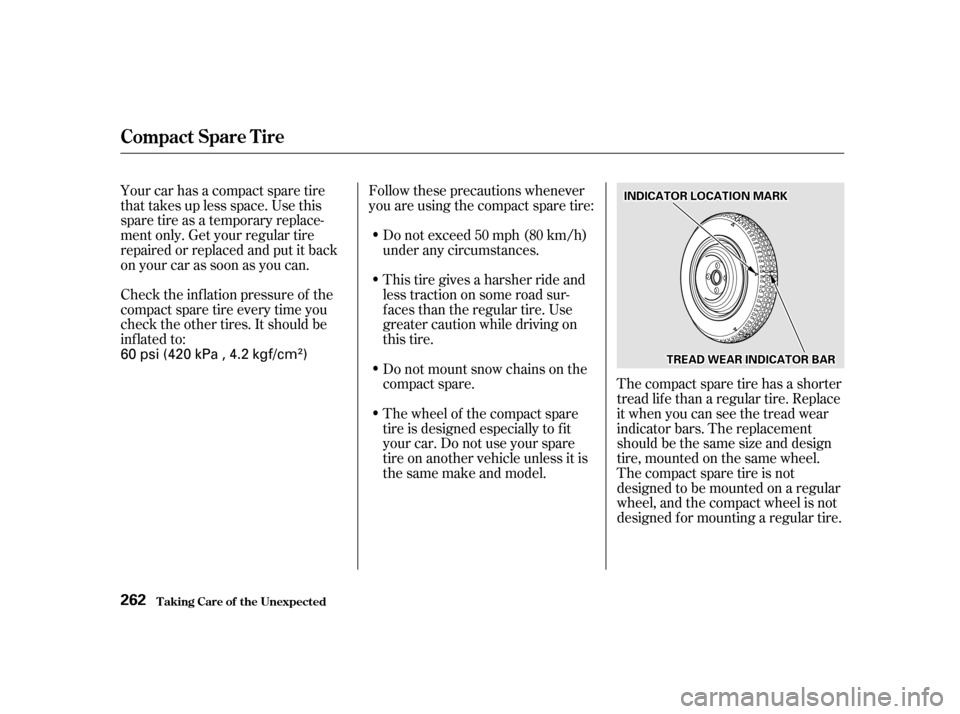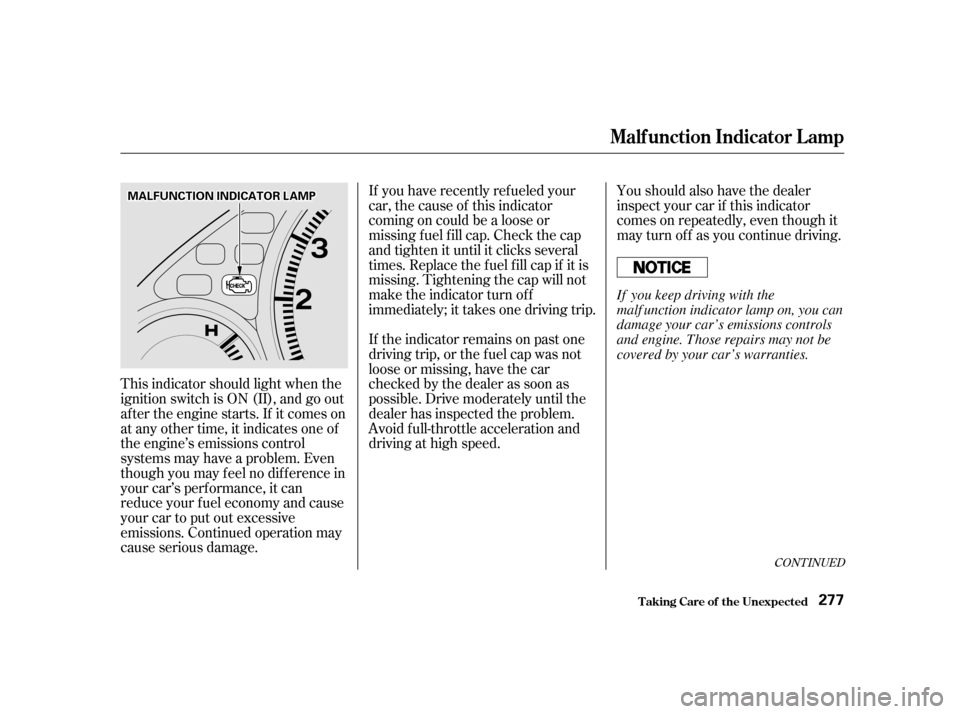Page 230 of 319
The air conditioning f ilter removes
pollen and dust that is brought in
f rom the outside through the heating
andcoolingsystem.To replace it:
This f ilter should be replaced every
30,000 miles (48,000 km) under
normal conditions. It should be
replaced every 15,000 miles (24,000
km) if you drive primarily in urban
areas that have high concentrations
of soot in the air f rom industry and
diesel-powered vehicles. Replace it
more of ten if air f low f rom the
heating and cooling system becomes
less than usual.
The air conditioning f ilter is located
behind the glove box.
Open the glove box. Remove the
hooks on the side panels by pulling
out on the tabs. Pivot the glove
box out of the way. Remove the air conditioning f ilter
cover by pushing in on the lock tab,
then pulling the cover toward you.
1. 2.
CONT INUED
On U.S. EX and LX models
Maint enance
Replacement
A ir Condit ioning Filt er
231
HHOOOOKKSS
TTAABB
CCOOVVEERR
Page 234 of 319

Youshouldgetyourowntire
pressure gauge and use it whenever
you check your tire pressures. This
will make it easier f or you to tell if a
pressure loss is due to a tire problem
and not due to a variation between
gauges.
The following chart shows the
recommended cold tire pressures f or
most normal driving conditions and
speeds.Thecompactsparetirepressureis:
These pressures are also given on
thetireinformationlabelonthe
driver’s doorjamb.
Tubeless tires have some ability to
self -seal if they are punctured.
However, because leakage is of ten
very slow, you should look closely
for punctures if a tire starts losing
pressure.
Honda strongly recommends that
you not drive f aster than posted
speed limits and conditions allow. If
you decide it is safe to drive at high
speeds, be sure to adjust the cold tire
pressuresasshownbelow.If youdo
not adjust the tire pressure, exces-
sive heat can build up and cause
sudden tire f ailure.Tire Pressures f or high speed
driving are the same as f or normal
driving.
When you return to normal speed
driving, be sure to readjust the tire
pressure f or normal driving. You
should wait until the tires are cold
bef ore adjusting the tire pressure.
(DX, LX)
(EX) (DX, LX)
Tire Size Cold Tire Pressure for Normal Driving
Tire Size Cold Tire Pressure for Normal Driving Tire Size
Cold Tire Pressure
for Speeds over 100
mph (160 km/h)EX models only
DX and LX models only
Recommended T ire Pressures f or
Normal Driving
T ire Pressure A djust ment f or HighSpeed Driving
Tires
Maint enance 235
P185/70R14 87S 30 psi (210 kPa , 2.1
kgf/cm
)
30 psi (210 kPa , 2.1 kgf/cm
)
P185/65R15 86H 35 psi (240 kPa , 2.4
kgf/cm
)
P185/70R14 87S
60 psi (420 kPa , 4.2 kgf/cm
)
Page 261 of 319

Follow these precautions whenever
you are using the compact spare tire:Thecompactsparetirehasashorter
tread lif e than a regular tire. Replace
it when you can see the tread wear
indicator bars. The replacement
shouldbethesamesizeanddesign
tire, mounted on the same wheel.
Thecompactsparetireisnot
designed to be mounted on a regular
wheel, and the compact wheel is not
designed f or mounting a regular tire.
Check the inf lation pressure of the
compact spare tire every time you
check the other tires. It should be
inf lated to:
Do not exceed 50 mph (80 km/h)
under any circumstances.
This tire gives a harsher ride and
less traction on some road sur-
f aces than the regular tire. Use
greater caution while driving on
this tire.
Do not mount snow chains on the
compact spare.
Your car has a compact spare tire
that takes up less space. Use this
sparetireasatemporaryreplace-
ment only. Get your regular tire
repaired or replaced and put it back
on your car as soon as you can.
The wheel of the compact spare
tire is designed especially to f it
your car. Do not use your spare
tire on another vehicle unless it is
thesamemakeandmodel.
Compact Spare Tire
T aking Care of t he Unexpect ed
262
IINNDDIICCAATTOORRLLOOCCAATTIIOONNMMAARRKK
TTRREEAADDWWEEAARRIINNDDIICCAATTOORRBBAARR
60 psi (420 kPa , 4.2 kgf/cm)
Page 276 of 319

If you have recently ref ueled your
car, the cause of this indicator
coming on could be a loose or
missing f uel f ill cap. Check the cap
and tighten it until it clicks several
times. Replace the fuel fill cap if it is
missing. Tightening the cap will not
make the indicator turn of f
immediately; it takes one driving trip.
If the indicator remains on past one
driving trip, or the f uel cap was not
loose or missing, have the car
checked by the dealer as soon as
possible. Drive moderately until the
dealer has inspected the problem.
Avoid full-throttle acceleration and
driving at high speed.Youshouldalsohavethedealer
inspect your car if this indicator
comes on repeatedly, even though it
may turn of f as you continue driving.
This indicator should light when the
ignition switch is ON (II), and go out
af ter the engine starts. If it comes on
at any other time, it indicates one of
the engine’s emissions control
systems may have a problem. Even
though you may f eel no dif f erence in
your car’s perf ormance, it can
reduce your f uel economy and cause
your car to put out excessive
emissions. Continued operation may
cause serious damage.
CONT INUED
T aking Care of t he Unexpect ed
Malf unction Indicator L amp
277
MMAALLFFUUNNCCTTIIOONNIINNDDIICCAATTOORRLLAAMMPP If you keep driving with the
malf unction indicator lamp on, you can
damage your car’s emissions controls
and engine. Those repairs may not be
covered by your car’s warranties.